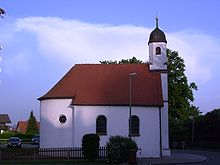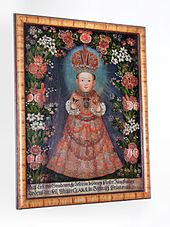St. Johann Nepomuk (Eisenburg)
The St. Johann Nepomuk Chapel stands in the middle of Eisenburg , a part of the municipality of Memmingen , on a steep slope of the Memminger dry valley in the so-called Oberdorf. The patronage is St. Johann Nepomuk on May 16.
history
As early as 1747, the vicar general in Augsburg allowed the previous building, which was in extremely poor condition, to be demolished. Details about its construction time and its appearance are not known. The new branch of the Amendinger Church should be available to the faithful in bad weather on Sundays and public holidays and in the summer in the evening. The permission to build the new chapel in today's Oberdorf below the Eisenburg Castle was granted at about the same time as the demolition permit. Only on May 18, 1781 did the diocese of Augsburg allow the benediction by the dean Franz Johann Thies. A small sacristy with a sheet metal roof was added to the south side in 1956 .
location
The chapel stands free in the so-called Oberdorf von Eisenburg at an altitude of 641 meters above sea level. In the west it is only separated from the road connecting Lauben and Trunkelsberg by a sidewalk , which is followed by the war memorial on a slope . Because of the narrow point formed by the chapel, the road is only passable in one lane. There is a parking lot on the northern side of the chapel, after which residential development begins. A farm is attached to the fire station in the south of the district. The local kindergarten is located next to a green strip on the east side of the chapel.
Building description
The chapel is divided into a nave with two window axes and a somewhat recessed, semicircular closed chancel.
Exterior construction
The exterior is simply plastered. In the west facade, the entrance area is decorated with a blind arch . The bell tower is octagonal on the upper floor and has round-arch sound windows and a curved hood, which is closed with a lower hospital cross . On the west side there is a tower clock below the sound opening. The chapel has a gable roof , which is rounded towards the east by the sanctuary.
Interior construction
The flat barrel vault of the nave is structured with pilasters . There are two large arched windows on the south and north sides. A strongly curved gallery is built into wooden supports above the entrance area on the west side. The chancel also has a pilaster structure. It is illuminated through two small circular windows . The chapel has been renovated three times (1887/88, 1955/56 and 1994/95).
Furnishing
The chapel is well equipped for its size. The high altar is likely to have been erected in the middle of the 18th century, when the chapel was built. It has smooth, twisted free columns with gilded capitals . On the sides there are angel heads with large acanthus tendrils that roll into volutes , and other smaller figures. At the center of the extract is a monogram of Mary , accompanied by two angel putti sitting on pieces of entablature. In 1817 Konrad Huber's image of the Virgin with the baby Jesus was placed in the high altar. The representation is one of the so-called Byzantine Hodegetria . Other high-quality works, especially carvings, include a Virgin and Child dated around 1420 as well as a John the Baptist and a Christ as a good shepherd from the first half of the 18th century . The figures of St. Nepomuk and a triumphal cross are estimated to be around the middle of the 18th century . The lay chairs made of softwood with curved cheeks dates from the 18th century.
Bohemian image of Christ
The Bohemian image of Christ used to hang in a forest chapel on the way from Eisenburg to Otterwald , where Bohemian glassblowers were based. His model is the statue of Gratiosus Jesulus Pragensis from the Poor Clare Monastery in Krummau . The glassblower Simon Fuchs, who came from the Bohemian Forest , probably brought it with him when he moved to Otterwald in the early 18th century. It hung under the gallery until 1954 and was in extremely poor condition. It was not until Sepp Skalitzky discovered that it was a Bohemian image of Christ that it was painstakingly restored in 1954 and hung in the choir room. The then still independent municipality of Eisenburg bore the costs.
It is 100 centimeters high and 77 centimeters wide and was probably created at the time of the baroque, which could be seen from the flower border surrounding the baby Jesus. The main motifs of this floral wreath are symmetrically arranged roses and poet's daffodils , lilies of the valley and cornflowers. In the lower part of the picture, instead of the wreath of flowers, there is the inscription “That love: and gracious Jesuleiin bey the Closter Virgins Order of Salvation Mother CLARAE in Bohemian Crummau.” The child Jesus figure is the central theme of the picture. She is shown with a cheerful child's face with protruding ears, brown eyes and a small smiling mouth and wears an oversized royal crown adorned with precious stones with an orb. The child's dress is red with rich decorations and a rosary and a crucifix. The child holds a rose in the right hand and a flaming heart in the left. It wears a ring on each finger.
Bell jar
The tower bell was cast in 1787 by the Memmingen bell foundry Johann Georg Ernst and in 1802 it was acquired and hung by the parish. It has a diameter of 45 and a height of 38 centimeters. Her shoulder bears a laurel bar frieze ribbon made of branches with flowers, starting from a lion's head and ending at opposite palmettes . The flank shows the Mother of God and a Bavarian Marientaler with the inscription "Patrona Bavariae 1780". Below is a cartouche with the donor's coat of arms of the Barons von Osterberg and a five-pointed crown with the inscription “IOHANN GEORG ERNST GOS MICH IN MEMMINGEN”. The crown bow has a sheet mask on the front. According to the former teacher from Eisenburg, the bell was purchased in 1802 for 50 guilders. The barons of Osterberg paid interest on the debt for this bell annually until 1827 with 2 guilders 30 crowns.
Web links
literature
- Carmen Roll: Memmingen-Amendingen >> St. Ulrich << . Catholic Parish Office St. Ulrich Memmingen-Amendingen, Feiner Druck, Memmingen 2000.
- Tilmann Breuer: City and District of Memmingen . Ed .: Heinrich Kreisel and Adam Horn. Deutscher Kunstverlag, Munich 1959, p. 98 .
Individual evidence
- ↑ a b c d e City and District of Memmingen, 1959, page 98
- ↑ Memmingen-Amendingen >> St. Ulrich <<, page 24
- ↑ BayernViewer of the Bavarian Surveying Administration. (No longer available online.) Archived from the original on April 3, 2016 ; Retrieved December 29, 2009 . Info: The archive link was inserted automatically and has not yet been checked. Please check the original and archive link according to the instructions and then remove this notice.
- ↑ a b Dehio Bayern III: Schwaben, page 303
- ↑ Spiegelschwab, local supplement of the Memminger Zeitung , year 1954, No. 9, pages 1 and 2, Sepp Skalitzky: The bohemian Christ image to Eisenburg
- ^ Franz Dambeck and Günther Grundmann: German Bell Atlas . Deutscher Kunstverlag Munich Berlin, 1967, p. 352-353 .
Coordinates: 48 ° 1 ′ 2.5 ″ N , 10 ° 12 ′ 47.5 ″ E



